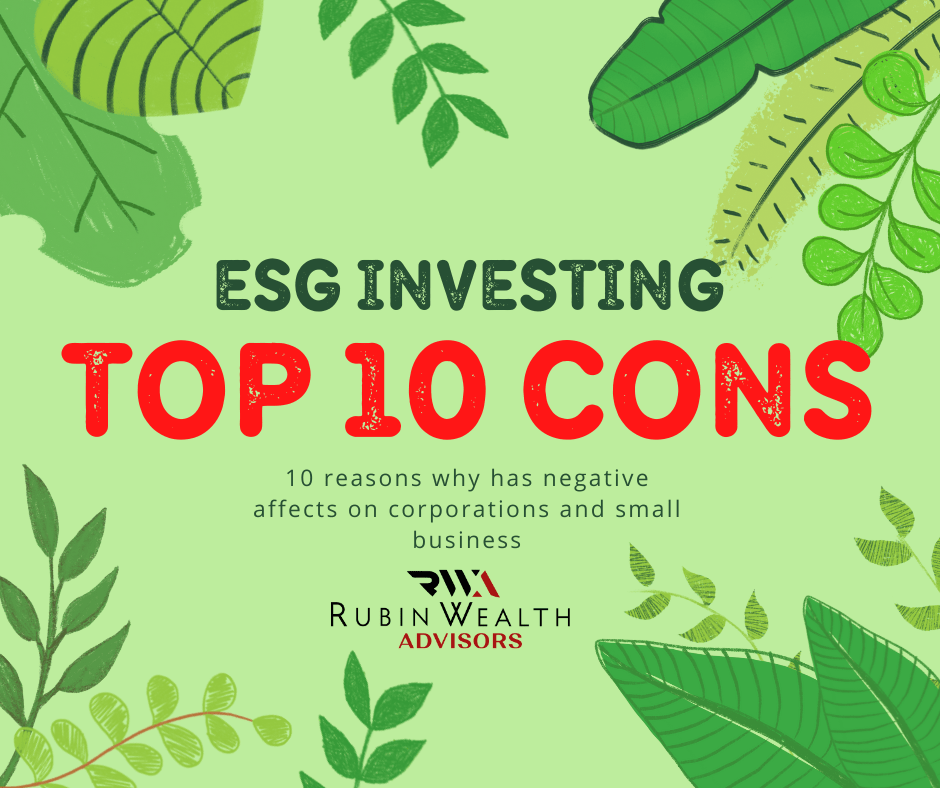The Concept of ESG Investing has Evolved in Something Negative.
/in Uncategorized /by Chris Linscomb
From a half-baked idea among UN low-level staff, the green Frankenstein of Wall Street has grown into a multibillion-dollar company. One estimate puts the global value of ESG investments at nearly $2.8 trillion.
There are few guidelines surrounding the acronym, making it an undefined symbol with little guidance. In other words, farmers could market vegetables as organic but with no genetic engineering restrictions.
ESG pioneers are surprised by all of this.
As a result of ESG investing, Paul Clements-Hunt, the former UN chief, stated that the goal was to “plant a positive virus that we could spread throughout mainstream finance and investment” to raise awareness that these issues matter, they affect your long-term investments, and they matter to your bottom line. UNEP FI, which played a crucial role in popularizing the idea, played a vital role in popularizing the concept.
Whether ESG ends up for good or for foul, he said, “it is hard to believe.”
ESG took to the next level
How did it all begin?
It’s impossible to give a definitive answer. But, according to experts, the UN’s bare-bones office was the point of origin for this initiative in the early 2000s.
Under Clements-Hunt’s leadership at UNEP FI, a bold goal was established: mobilizing the world’s largest investors to address major global issues. As a stable environment and a prosperous world contribute to a more prosperous economy, the UN’s priorities are aligned with those of long-term investors.
The concept of socially responsible investment was already available from niche investment companies, religious groups, and other organizations. However, specific sectors, such as weapons manufacturers, were excluded from investment funds.
The United Nations had an ethical appeal, but they knew institutional investors were obligated to prioritize financial returns above all else and that more would be needed to lure their attention.

“In 2000, Jacob Malthouse joined UNEP FI as an intern and was challenged with breaking out of the then-standards of socially responsible investment, called SRI and ethical investing.
To convince the world’s most significant pension funds of the importance of biodiversity, human rights abuses, and climate change, they developed a plan to raise these issues. Additionally, they wanted to demonstrate that taking into account companies’ records on environmental, social, and governance issues – and their risk management practices – actually improves investing, not hinders it.
An incomplete investment process does more than ignore supply chains and labor practices, they argued. That’s a false statement.
A few roadblocks soon appeared. Nevertheless, a big goal and a small team were the hallmarks of the Finance Initiative. A few consultants or interns make up most of Malthouse’s office, which is operated on a shoestring budget.
Financial institutions themselves are another major hurdle.
Even though mainstream finance firms have yet to accept that environmental and social performance can affect their bottom lines, environmental and social issues have impacted businesses’ bottom lines for years. According to pension funds, they are legally prevented from considering “nonfinancial” factors when investing because of their so-called fiduciary duty.
A landmark research paper was commissioned by the Finance Initiative to address those concerns.
A 2004 report by mainstream brokerage house analysts argued that long-term financial returns depend on the “rigorous integration of environmental, social, and corporate governance issues” into investment processes. Analysts at Goldman Sachs Global Energy Research, HSBC Asset Management, and Deutsche Bank Global Equity Research made this argument.
The first time the three words have been used together in an official UN publication.
An institutional law firm, Freshfields Bruckhaus Deringer LLP, published the second report. “Incorporating ESG considerations into an investment analysis to improve financial performance prediction is permissible and arguably required in every jurisdiction.”, the firm wrote in 2005.
Carlos Joly, who chaired the UN’s Asset Management Working Group for over a decade, said the findings finally allowed U.S. institutional investors to take this approach.
E&E News recently reported that experts with the UN’s work at the time said a landmark effort to coordinate and draft “principles for responsible investment” – the PRI – was equally important.
Sustainability data was infused into their investment processes to motivate asset owners to invest more responsibly and even leveraged to push companies toward a greener future.
It was successful. Over $6.5 trillion in assets were represented by 63 signatories when the PRI was launched in 2006, including BNP Paribas Asset Management and the Government Employees Pension Fund of South Africa. Since then, those figures have risen dramatically. Over $121 trillion in assets were represented by nearly 3,900 investment institutions by 2021.
Gifford attributed much of that growth to one factor he pitched in his sixth week as an intern. Other institutions, such as asset managers, had to get on board to compete for their business.
Credit Suisse’s Sustainable and Impact Advisory executive, Mark Gifford, says the PRI paved the way for ESG to reach the next level.
If you’re more interested in achieving financial gains instead of perpetuating failed strategies, call Rubin Wealth Management to learn more.

Are you concerned about inflation, ESG compliances, and the 2022 crypto crash?
Your investment portfolio can be affected by any or all of these factors.
Schedule an appointment with Bob Rubin, your dedicated, conservative financial advisor, for a free portfolio analysis today.
Get started by clicking the button below.
Related Articles
No BS… Just straight forward advice
Contact Bob, the Nation’s Predominant
Politically Conservative Financial Advisor Today!






